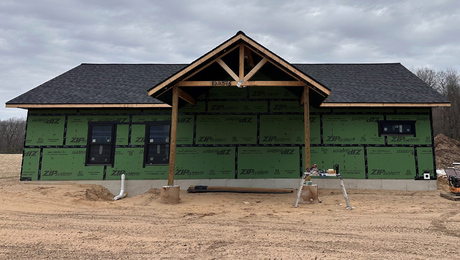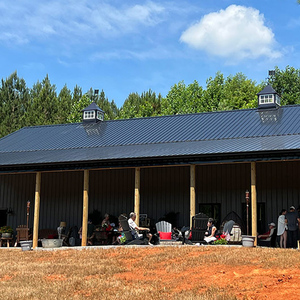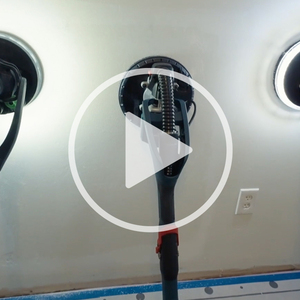Hi there. New member, first time poster.
I’m getting ready to build an addition on my home. We have the plans drawn and stamped, and the permit’s pulled. I’m having reservations about the roof design and wanted to run it by the gurus here.
The addition is two-story with the second story dimensions 24′ X 12’4″. We’re framing the second story four walls and a hip roof. Here’s the thing though, the hip roof is a cathedral ceiling. Basically, a 2X10 ridge board, 2X10 hip rafters and 2X8 common rafters 16″ OC . Will this work with no ceiling joists, nor rafter ties, nor gussets? Basically, the way I understand it, there is nothing to take the thrust load of the rafters besides the frame walls. I addressed my concern to the draftsman and he said not to worry about it because the roof is only bridging a span just over 12′
Should I worry about this design? Will this be a problem, if not now, in the future with the walls bowing?
Thanks for any help!
–Greg



















Replies
Why would we expect a draftsman to know engineering? He is probably pretty good at drawing lines, but lines on paper stay where you put them.
And
how in the world did you get it approved and permitted withoput having the structure detailed on this point?
Yes
You should worry about this design. It can be engineered, but not by this line jockey.
I'd be looking at LVLs for the major players and a custome made bolt on joint at the junction of hip and ridge, maybe hip to plate connector too.
Welcome to the
Taunton University of Knowledge FHB Campus at Breaktime.
where ...
Excellence is its own reward!
I wish I had a dollar for every time I heard the phrase...
"My designer said it will work, so just do it!"
Atleast this one is not buying it hook, line and sinker.
Funny thing is that the plans ARE signed by an engineer and the plans are APPROVED by the permit review board or committee (or whatever). I'll personally call the engineer tomorrow and see what he says in person. Thanks!
That's unbelievable!
Welcome to the Taunton University of Knowledge FHB Campus at Breaktime. where ... Excellence is its own reward!
Yes, you should worry. You have an 11' 8" ridge board, this will be the vulnerable area. You should have ties at each end of the ridge and 2 between those, with conventional framing methods. You should consult an engineer for this roof design. The engineer will be able to offer you alernative conection and design methods to accomplish what you want. (they all will involve more cost)
You've got a good, reasonable question. Others have already answered it for you.
Good questions and patience will serve you well on your project.
Keep following your gut instinct about things, it seems to be serving you well! buic
2x8s are fairly large for the short span, so it could be that the engineer has actually thought it through and the details simply got lost along the way. My guess is the lost detail is a tie of some sort, perhaps a steel widget up high.
Best of luck
Beer was created so carpenters wouldn't rule the world.
It would take that much and more to get the required unsulation for a roof.
Welcome to the Taunton University of Knowledge FHB Campus at Breaktime. where ... Excellence is its own reward!
7-1/4" of foam wouldn't be too bad. You're right though, it's marginal at best with anything short of foam.
Beer was created so carpenters wouldn't rule the world.
Having read the other posts here, and sat down with Admiral Halsey and drunk the obligatory "cup of tea". You've got the approvel's here but you wonder if it won'nt bow a little bit down the road. Cool, don,t blame you. Use the flat of the soffitt as a box beam. Cut the rafter tails on the 12 ft. straight part tall and apply 3/4 inch plywood shear panels. don't tell the engineer, he might not sleep for a month trying to figure out how it wont work. Just do it and sleep well knowing it will. Pay attention to the HIP TO PLATE joints. Jim
THE METHOD I USE WHEN DOING CATHEDRALS IS TO DO 2X6 FRAMING AND USE 4 TOP PLATES TO MAKE A STIFF WALL. IF YOU CANN0T DO A CONTINOUS RUN ALTERNATE THE SPLICES AS MUCH AS POSSIBLE.
That would have some value to it. A similar resistance method has been mentioned here before of using an LVL turned perp to the rafters let in to them outside the wall.But it really should have an engineer run some calculatuions. Getting it right by guwesswork runs the chance that either you spend too much on wood and labour on one hand overbuiilding or ending up underbuilding and having a sag.
Welcome to the Taunton University of Knowledge FHB Campus at Breaktime. where ... Excellence is its own reward!
Greg, do the plans specify any hardware for the joinery? Or is it just notched rafters and toe nailing? That might make a difference.
Thanks for all the great replies so far! This is a great board.Here's the quick skinny on the connectors. I live in FL (120 mph), so the ridge to hip rafter is a HRC1.81, hip rafter to top plate (corner) is HCP1.81, ridge to rafter is a RR, and finally the rafter to top plate to stud is H10S.I'm reasonable certain the uplift and holdown are covered. My biggest concern is just the thrust.I'm thinking the best solution is a rafter tie on each rafter, about 1' verticlly above the wall height, and drywall the ceiling like a tray ceiling. Keeps a little extra volume of a cathedral while providing a rafter tie to relieve thrust loads. Eh???
If you want to keep the ceiling open, wall ties every four feet will do the job just fine. You could then finish them off as beams.
Here's the way we do this,
http://www.chandlerdesignbuild.com/files/fhbIss178.pdf
You'll need one flitch at each end of your ridge
Have fun
Michael
"You cannot work hard enough to make up for a sloppy estimate."
I guess iv'e learned something again, I think the engineer is correct. If you picture just the basic structure, the plates, the ridge and the hips before the rafters it would be self supporting, add the rafters and roof sheathing, the hip- rafter to plate connections would be important but the roof sheathing would be adding cosiderable strength laterally. The ridge could be doubled, or double with lvl's to make a combination ridge beam. You have paid for the plan check and engineers stamp so I would talk to plan check and the engineer. I have built something very similar but we added a exposed structural-decoarative collar tie spiked to first common raters at plates at each end of ridge creating a truss holding each end of ridge beam. FDC
A couple of things come to mind:
With hip ridges (2x10) greater depth than rafters (2x8), the ceiling can't be "smooth" finished around the corners as the 2x10's will project below the 2x8 rafter/ceiling surface. (won't they?)
Your collar tie idea with ties about 12 inches up from the plate could work but it's important to coordinate ceiling laps with the rafters in both directions.
I've designed brackets that the hip ridges connect to and that tie into the top plates to resist thrust basically by providing a "hoop" tie around the top plate. It's important to install this so that it is a complete loop or somehow it must tie back into the house to "complete" the hoop.
The main things are providing enough hoop strength at the top plate AND connection the hip ridges at the corners.
I've also designed the "bent" flitch beam before. the main thing there is to control outward spread of the beam.
There are other articles I've seen in the past. Check out Journal of Light Construction archives too.
Hope this helps. Your engineer may already have thought of these options. I'd strongly encourage you to pursue the question with him/her.
might be able to double up hips with same size jacks and common rafters FDC
Edited 3/1/2007 4:29 pm ET by FDC
it depends on the pitch of the roof wether or not the hips would stick down farther than the rafters.
I don't think so.
For example on a hip roof, a 2x10 hip ridge will project below adjacent rafters that are 2x8. The only way to provide a "flush" ceiling condition is to match the depth of the hip ridges and the rafters.
That is my (admittedly limited) experience. Perhaps some of the more experienced framers can clarify this. My guess is that this information is available in a good reference book on framing too.
The key is the ridge beam - that is, it HAS to be designed as a beam. If it is a beam, supported adequately at both ends, then you don't need collar ties. You do need adequate depth for insulation, which can be done in 7 1/4" with spray foam (for instance, although, of course, you ARE in Florida). There is a greater risk of movement, cracks and condensation with this system.
You could do a 'bent flitch' for the ridge and down the slope of the hip (mid-point) similar to the design illustrated in the chandlerdesignbuild article attached above (nice article). The 'bent beam' ridge moves the end bearing reaction of the ridge down to the plates.
Jeff
Edited 3/1/2007 11:05 pm ET by Jeff_Clarke
Thanks Jeff. What I did today was spoke with the building inspector about changing our ceiling from a cathedral to tray by adding 2X4's to each rafter like rafter ties, but I didn't want to call them rafter ties because I didn't want this change to be considered structural. We're not changing anything about the original "approved" design, but only adding a nailing surface for the tray ceiling drywall.I think these 2X's will add enough to help with the thrust load, and the inspector agreed the change is minor and will not need to be redrawn and resubmitted. Sound reasonable?I welcome anyone's input/opinions.Thanks again!
Edited 3/1/2007 11:46 pm ET by gjferg
If rafter ties are below the 1/3 point (no higher than 1/3 the height from plate to ridge) then they are effective.
Jeff
Since the engineer's stamp is on the drawing, the roof should be built as drawn.
I design 26'x32' hip roofs using 2x6 rafters, a 2x8 ridge, and 2x10 hips, but then I also put my stamp on the drawings.
But is that 26X32 roof also a cathedral ceiling? Did you have anything tying the rafters together (other than the ridge and the walls)?
The section of the roof that concerned me was the 11+ foot ridge board and common rafters.
You've had some very good suggestions here. Bottom line is that there are probably a hundred easy ways to make this work. One thing I have seen done that looks good is to have threaded rods connecting the walls. This is of course a matter of taste. You would need to have some connectors made up for the plate-to-rod connections, and of course an engineer or architect's calculations to cover you.
In any case, even with a narrow room like this, you need to have a structural post at each gable to hold up the LVL ridge. It sounds like you are making one huge room. If you are actually building a wall at about the midpoint, you could tie the center together easily without any ugly factor.
Another option is to add a post in the center of the structure. This would hold you down to two spans of twelve feet, which could work fine with a dimensional ridge beam. Make sure the post is supported through each level of the house.
Or, you could ... so many ways and so little time ... decisions, decisions, decisions!